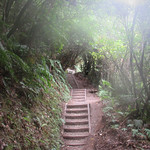|
0 Comments
When you close your eyes and think of nature, what do you see? When I was younger, I would see lush green forests, bounding hilly grasslands, snow-capped mountaintops, fields of wildflowers, and cascading waterfalls pouring into crystal-clear lakes. Birds flutter around, singing their songs as deer browse the grass. Bears asleep in their dens and butterflies pollinating the vast flowerscape. Fishes blub and jump carelessly in their ponds, splashing droplets of water that sparkle in the mid-morning sunlight. Pristine is a word I would often use. But why would I use it? Pristine is a loaded word when it comes to nature. On its own, pristine is a state of originality. Of being untouched. It is what would be if nothing interacted with it, whatever it may be. When it comes to nature, what, exactly, didn't touch it? What makes nature pristine? If you're going by our terms today, this would refer to a time before man, specifically European settlers. When we think of "what nature was before" it is asked from the perspective of the one asking the question. As with most modern questions and philosophy, this revolves around old white folks. What did nature look like before Europeans arrived. This perspective dominated (and frankly still dominates) our concept of an untouched nature. Personally, I think this is off. It's kind of full of holes. And it severely underestimates the connectedness humans have always shared with nature. In short, this perspective treats indigenous peoples as "not as human" as the people who came to their home. This is often cited as "they were a part of nature rather than a visitor to nature" framing the European settlers as "outside of nature." What's weirdest to me is that this also misses that Europeans are also indigenous to their homes, but Europe apparently isn't pristine, or can't be because history is written there. We can't compare Europe to a time prior to European history because it starts there. But everywhere else, yeah, that can be pristine. Now, I won't suggest colonization didn't end up fundamentally changing both the surrounding environment and communities. It still does today. But that's a choice. A way humans interact with the Earth. We don't get to choose that we're outside of the systems that govern the planet unless we leave the planet. Until then, we're always a part of nature. Our actions are held within, not beside. One example I'll be covering in an upcoming page is the prairies of the midwestern United States. Prior to European settlement, there were humans interacting with the land. In fact, they used it to their advantage in ways other animals couldn't. In doing so, they developed an ecosystem unique to their interactions: the tallgrass prairie. This environment is one maintained by recurring controlled fires. It clears out plants that are not resilient to fire, leaving tolerant old growth, and giving space for tolerant new growth to come in. This new growth is particularly enticing for native wildlife, like buffalo, who would cycle their grazing areas for easier food. The indigenous peoples did this purposefully as a means to use the land to their advantage. And that isn't to say this was always done with sustainability in mind. It's generally hypothesized that wildlife herds were often in low, controlled populations due to the success of this style of hunting. We often think this wasn't the case because by the time European settlers made it this far west, they were documenting massive numbers of native wildlife, seeming that indigenous peoples didn't hunt that much. In reality, by the time the settlers made it this far, the disease they brought to North America had already wiped out a massive chunk of indigenous populations, obviously resulting is less hunting. Those who wrote the history couldn't see what it was actually like because side effects of their arrival impacted the norm to a point where they couldn't see it. What the settlers saw as "pristine" was not true pristine since it was already impacted by their arrival. Even if that were avoided, the indigenous peoples were modifying the land from its pristine state. We have two layers of human touch, and we didn't get to accurately document even the one where indigenous peoples are considered a part of the untouched nature. It's a silly goal in hindsight. Since we're fresh from a trip to New Zealand, those islands are an interesting example too. The first settlers of New Zealand were the Maori people, who named it Aotearoa or "Land of the Long White Cloud." Fun fact, this name came from the snow-capped mountains which either looked like, or were mistaken for, a long white cloud. These people were sea-faring folks, and when they landed, the native wildlife was not used to predators. One such animal was the Moa, a bird much easier to hunt than maintaining the chickens they were used to. The ease of hunting these animals led to a very quick, by geological standards, extinction. This is not a frowning upon the Maori people either. Despite this information, they have utmost care for the land. It's just another example of humans, indigenous or otherwise, interacting with the Earth. Europeans aren't the only ones to push nature to a point that breaks it in some way. In many ways, pushing the planet to new limits, or in ways not really intended, is what humans do. It's what we've always done no matter where we are. And we've literally covered this planet. There really isn't a place on Earth that we haven't touched. Arguably, if we found such a place, it is impacted by our global actions regardless. Trying to categorize which humans did the touching sidesteps that humans are doing the touching. How we interact really just comes down to culture. Looking at our collective past, we can see that we've made some mistakes. Okay...A LOT of mistakes. But we can also do great good. We have recognized that we're a part of this planet across our species' history, and we can continue to shape that. We can continue to be a part of nature and make sure its always their to work with. That it's always there to call home. One of the cool ways to consider this is that nature isn't pristine. We've always been a part of it. Humans have always taken nature and expanded on it. And if we strive for a culture where a coexistence with nature is key, we don't have to just preserve it. We don't have to settle on restoring it. We can make more of it. ~ And, as always, don't forget to keep wondering ~ While this post is largely personal opinion and observation, I was inspired to this topic by Emma Marris' book, Rambunctious Garden, specially chapter 2, "The Forest Primeval." The post certainly takes some paraphrasing from her book :)
Sources * Marris, Emma. Rambunctious Garden: Saving Nature in a Post-Wild World. Bloomsbury, 2011. |
AuthorPrismatic Planet wants to get excited for the planet, raise awareness of its inhabitants, and get smarter about Earth. Archives
July 2024
Categories |







 RSS Feed
RSS Feed